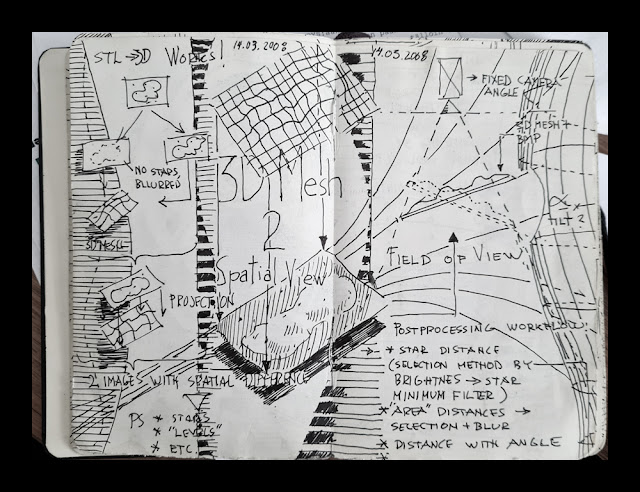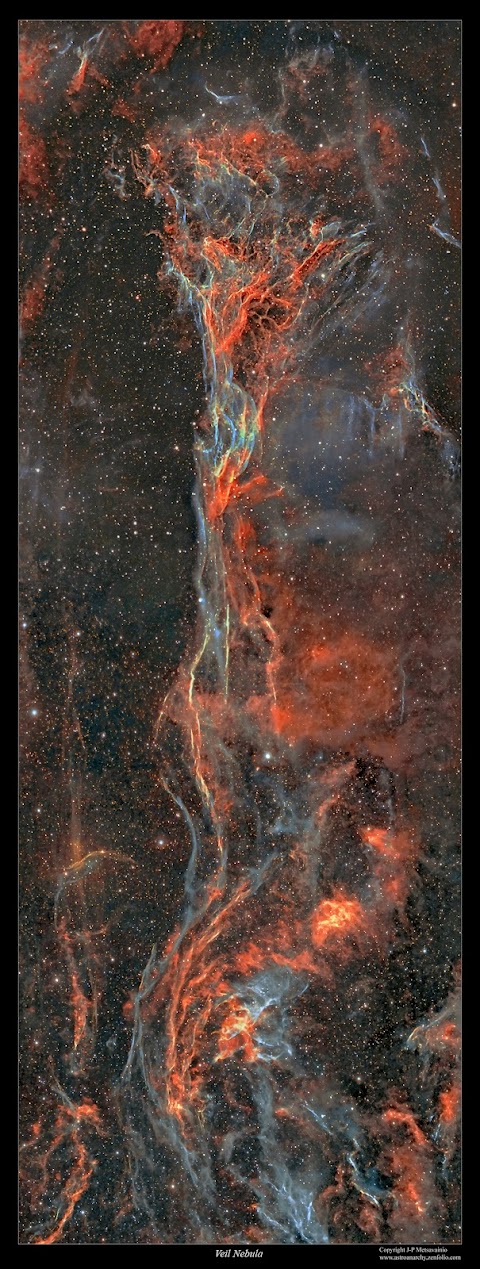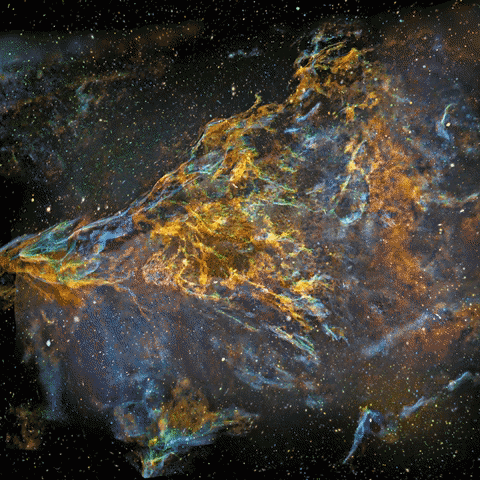COPYRIGHT, PLEASE NOTE
Thursday, October 7, 2021
Filaments of Veil in mapped colors
I shot most of the lights for this image back in 2016, now I have added some new material to it and reprocessed the whole image. A version in visual color palette can be seen here, https://astroanarchy.blogspot.com/2021/09/filaments-of-veil-nebula-snr.html
Photo was shot with a Celestron Edge HD 11" telescope, Astrodon naarrow band filters and Apogee Alta U16 astro camera. New data is shot with a shorter focal length instrument, Tokina AT-x 300mm f2.8 camera lens, same camera and filters. Dim background emission is taken from a new material and added to this photo.
Total exposure time is now 44 hours for the whole three frame mosaic and the resolution is 11.000 x 4000 pixels.
Click for a large image
Every single pixel in this 3d-animation is from the original 2D-image above. The model is based on on known scientific facts, deduction and some artistic creativity. The result is an appraised simulation of reality. Astronomical photos are showing objects as paintings on a canvas, totally flat. In reality, they are three dimensional forms floating in three dimensional space. The purpose of my 3d-experiments is to show that and Give an idea, how those distant objects might look in reality.
Wednesday, October 6, 2021
Unveiling The Veiled
The Veil nebula supernova remnant in Cygnus. Original image was shot with the Canon EF 200 mm f1.8 camera optics full open, QHY9 astro camera and Baader narrowband filters at 2013.
New data is shot with Tokina 300mm f2.8 camera optics and Celestron Edge HD 11" telescope, Apogee Alta U16 astro camera with Astrodon narrowband filters between 2016 - 2020
Total exposure time is now about 45 hours.
The Veil nebula @SuperRare auction
Animation, https://superrare.com/artwork-v2/unveiling-the-veiled-volume-29145
Photo, https://superrare.com/artwork-v2/unveiling-the-veiled-29137
Veil nebula Unveiled
Click for a large image, 1250 x 1700 pixels
Nebula in visual colors from light emitted by an ionized elements can be seen here,
https://astroanarchy.blogspot.com/2021/09/veil-nebula-unveiled-ii.html
Every single pixel in this 3d-animation is from the original 2D-image above. The model is based on on known scientific facts, deduction and some artistic creativity. The result is an appraised simulation of reality. Astronomical photos are showing objects as paintings on a canvas, totally flat. In reality, they are three dimensional forms floating in three dimensional space. The purpose of my 3d-experiments is to show that and Give an idea, how those distant objects might look in reality.
INFO
How the 3D-model is made
 My Moleskine notebook pages from 2008, I planned how to convert nebulae to 3D
My Moleskine notebook pages from 2008, I planned how to convert nebulae to 3D
Monday, October 4, 2021
Three 3D-conversions out of my astronomical photos
I have made dozens of 3D-conversions out of my astronomical photos. As an artist I like to find a new views to the reality. My models are not just a guesswork, the conversion is based on real scientific data.
At the end of this blog post there is a short explanation, how I do my conversion work.
Original astronomical photo about part of the Veil nebula SNR in O-III light only.
3D-study of Veil Nebula Photo
How 3D-models are made My Moleskine notebook pages from 2008, I planned how to convert nebulae to 3D
My Moleskine notebook pages from 2008, I planned how to convert nebulae to 3D
How accurate my 3-D-visions are depending on how much information I have and how well I implement it.
The final 3-D-image is always an appraised simulation of reality based on known scientific facts, deduction, and some artistic creativity.
After I have collected all the necessary scientific information about my target, I start my 3-D conversion from stars. Usually there is a recognizable star cluster which is responsible for ionizing the nebula. We don’t need to know its absolute location since we know its relative location. Stars ionizing the nebula have to be very close to the nebula structure itself. I usually divide up the rest of the stars by their apparent brightness, which can then be used as an indicator of their distances, brighter being closer. If true star distances are available, I use them, but most of the time my rule of thumb is sufficient. By using a scientific estimate of the distance of the Milky Way object, I can locate the correct number of stars in front of it and behind it.
Emission nebulae are not lit up directly by starlight; they are usually way too large for that. Rather, stellar radiation ionizes elements within the gas cloud and the nebula itself is glowing light, the principle is very much the same as in fluorescent tubes. The thickness of the nebula can be estimated from its brightness, since the whole volume of gas is glowing, brighter means thicker.
By this means, forms of the nebula can be turned to a real 3-D shape. Nebulae are also more or less transparent, so we can see both sides of it at the same time, and this makes model-making a little easier since not much is hidden.
The local stellar wind, from the star cluster inside the nebula, shapes the nebula by blowing away the gas around the star cluster. The stellar wind usually forms a kind of cavity in the nebulosity. The same stellar wind also initiates the further collapse of the gas cloud and the birth of the second generation of stars in the nebula. The collapsing gas can resist the stellar wind and produces pillar like formations which must point to a cluster.
Ionized oxygen (O-III) glows with a bluish light, and since oxygen needs a lot of energy to ionize it, this can only be achieved relatively close to the star cluster in the nebula. I use this information to position the O-III area (the bluish glow) at the correct distance relative to the heart of the nebula.
Many other small indicators can be found by carefully studying the image itself. For example, if there is a dark nebula in the image, it must be located in front of the emission one, otherwise we couldn’t see it at all.
Using the known data in this way I build a kind of skeleton model of the nebula. Then the artistic part is mixed with the scientific and logical elements, and after that the rest is very much like creating a sculpture on a cosmic scale
Thursday, September 30, 2021
Filaments of Veil Nebula SNR
I shot most of the lights for this image back in 2016, now I have added some new material to it and reprocessed the whole image. An older mapped color version can be seen here, https://astroanarchy.blogspot.com/2016/12/filaments-of-veil-nebula.html
Photo was shot with a Celestron Edge HD 11" telescope, Astrodon naarrow band filters and Apogee Alta U16 astro camera. New data is shot with a shorter focal length instrument, Tokina AT-x 300mm f2.8 camera lens, same camera and filters. Dim background emission is taken from a new material and added to this photo.
Total exposure time is now 44 hours for the whole three frame mosaic and the resolution is 11.000 x 4000 pixels.

Image is in visual palette from emission of an ionized elements, hydrogen (H-alpha), sulfur (S-II) and oxygen (O-III). Red=Hydrogen + 33% sulfur, Green=oxygen and Blue=oxygen + 33% hydrogen to compensate otherwise missing H-beta emission.
A closeup
Click for a large image
Every single pixel in this 3d-animation is from the original 2D-image above. The model is based on on known scientific facts, deduction and some artistic creativity. The result is an appraised simulation of reality. Astronomical photos are showing objects as paintings on a canvas, totally flat. In reality, they are three dimensional forms floating in three dimensional space. The purpose of my 3d-experiments is to show that and Give an idea, how those distant objects might look in reality. More info about my 3D-technique at end of this blog post: https://astroanarchy.blogspot.com/2021/10/unveiling-veiled.html
NOTE. It looks like that the animation has less stars, than the original 2d-image. That's not true, stars is normal photo are getting projected to a same plane. In 3D-model stars are in volume and it only looks like, that there are less stars.
Thursday, September 16, 2021
Viral Nebula Rocks
IC1396 converted to 3D animation, very first of its kind
NOW on SuperRare
I turned my photo of IC1396 to a 3d-model at 2012 to show that it’s actually a three-dimensional volume floating in three-dimensional space. This artwork is not just a guess work, it’s based on scientific data about the structure of emission nebulae and real distance information.
This animation went viral and it was published by several news media and major websites globally at 2012, links after the photos
Original photo used for the animation
My original photo of emission nebula IC1396
PETAPIXEL, Michael Zhang
Amazing Animated GIFs Capture Nebulae in 3D Using Artificial Parallax
https://petapixel.com/2013/02/20/amazing-animated-gifs-capture-nebulae-in-3d-using-artificial-parallax/
This animation was selected to a Moving the Still exhibition in Miami Art Week 2012
How the 3D-model is made My Moleskine notebook pages from 2008, I planned how to convert nebulae to 3D
My Moleskine notebook pages from 2008, I planned how to convert nebulae to 3D
For as long as I have captured images of celestial objects, I have always seen hem three-dimensionally in my head. The scientific information makes my inner visions much more accurate, and the 3-D technique I have developed enables me to share those beautiful visions with others.
How accurate my 3-D-visions are depending on how much information I have and how well I implement it.
The final 3-D-image is always an appraised simulation of reality based on known scientific facts, deduction, and some artistic creativity.
After I have collected all the necessary scientific information about my target, I start my 3-D conversion from stars. Usually there is a recognizable star cluster which is responsible for ionizing the nebula. We don’t need to know its absolute location since we know its relative location. Stars ionizing the nebula have to be very close to the nebula structure itself. I usually divide up the rest of the stars by their apparent brightness, which can then be used as an indicator of their distances, brighter being closer. If true star distances are available, I use them, but most of the time my rule of thumb is sufficient. By using a scientific estimate of the distance of the Milky Way object, I can locate the correct number of stars in front of it and behind it.
Emission nebulae are not lit up directly by starlight; they are usually way too large for that. Rather, stellar radiation ionizes elements within the gas cloud and the nebula itself is glowing light, the principle is very much the same as in fluorescent tubes. The thickness of the nebula can be estimated from its brightness, since the whole volume of gas is glowing, brighter means thicker.
By this means, forms of the nebula can be turned to a real 3-D shape. Nebulae are also more or less transparent, so we can see both sides of it at the same time, and this makes model-making a little easier since not much is hidden.
The local stellar wind, from the star cluster inside the nebula, shapes the nebula by blowing away the gas around the star cluster. The stellar wind usually forms a kind of cavity in the nebulosity. The same stellar wind also initiates the further collapse of the gas cloud and the birth of the second generation of stars in the nebula. The collapsing gas can resist the stellar wind and produces pillar like formations which must point to a cluster.
Ionized oxygen (O-III) glows with a bluish light, and since oxygen needs a lot of energy to ionize it, this can only be achieved relatively close to the star cluster in the nebula. I use this information to position the O-III area (the bluish glow) at the correct distance relative to the heart of the nebula.
Many other small indicators can be found by carefully studying the image itself. For example, if there is a dark nebula in the image, it must be located in front of the emission one, otherwise we couldn’t see it at all.
Using the known data in this way I build a kind of skeleton model of the nebula. Then the artistic part is mixed with the scientific and logical elements, and after that the rest is very much like creating a sculpture on a cosmic scale
Friday, August 27, 2021
Visions of Veil
This is an experimental test with a 3D-conversion of my astronomical image. Only real elements from the original image are used, there is nothing added but the estimated volumetric information!
NOTE. This is a personal vision about shapes and volumes, based on some scientific data, deduction and an artistic impression.Thursday, December 31, 2020
All my photos from year 2020
The year 2020 has been interesting since I'm between the scopes at the moment. I converted my old Tokina At-x 300 mm f2.8 camera optics and paired it with the Apogee Alta U16 astro camera.
At first it looked like an impossible task since the back focus distance of Tokina lens was way too short for the camera. After some heavy handed modifications (including an angle grinder) I managed to marry those too junks of metal, glass and silicon together. Kind of Frankenstein's monster but worked!
After many years shooting with a long focal length instrument it was like a fresh air to work with wide field tool.
All my photos from the year 2020
Click for a full size poster (2000 x 2800 pixels)
Photo 11, https://astroanarchy.blogspot.com/2020/04/two-ways-to-go-in-same-field-of-view.html
Photo 12, https://astroanarchy.blogspot.com/2020/11/a-supernova-remnant-in-cygnus-g65357-snr.html
This SNR is part of the Cygnus mosaic (Image 21).
Photo 21, https://astroanarchy.blogspot.com/2020/01/deep-in-to-my-heart-ic-1805-in-mapped.html
https://astroanarchy.blogspot.com/2020/12/cygnus-project-grande-finale-for-now.html
Cassiopeia to Cepheus
https://astroanarchy.blogspot.com/2020/12/from-cassiopeia-to-cepheus-eight-years.html
- Sh2-124, https://astroanarchy.blogspot.com/2020/11/sharpless-124-sh2-124.html
- Sh2--124 wide field
- Clouds of Cassiopeia, https://astroanarchy.blogspot.com/2020/11/cassiopeia-mosaic-gets-larger.html
- SNR CTB1, https://astroanarchy.blogspot.com/2020/02/ctb1-supernova-remnant-in-cassiopeia.html
- Simeis 147, https://astroanarchy.blogspot.com/2020/03/the-birth-of-venus.html
- Tulip nebula area, https://astroanarchy.blogspot.com/2020/10/the-tulip-nebula-in-cygnus-sh2-101.html
- Sh2-205, https://astroanarchy.blogspot.com/2020/03/a-rare-image-sharpless-205-and-ngc-1491.html
- NGC 1499, https://astroanarchy.blogspot.com/2020/01/a-deep-view-to-california-nebula-in.html
- Sh2-132, https://astroanarchy.blogspot.com/2020/11/a-new-photo-of-sharpless-132-sh2-132.html
- Sh2-126, https://astroanarchy.blogspot.com/2020/10/new-photo-sharpless-126-in-lacerta.html
- Sh2-216 & 221, https://astroanarchy.blogspot.com/2020/04/two-ways-to-go-in-same-field-of-view.html
- SNR G65.3+5,7,https://astroanarchy.blogspot.com/2020/11/a-supernova-remnant-in-cygnus-g65357-snr.html
- IC 63 & NGC281, https://astroanarchy.blogspot.com/2020/03/ic-63-and-ngc-281.html
- SNR IC443, https://astroanarchy.blogspot.com/2020/03/supernova-remnant-ic-443-wide-field.html
- Bubble to Cave, https://astroanarchy.blogspot.com/2020/03/from-bubble-to-cave-nebula-area.html
- Cygnus, https://astroanarchy.blogspot.com/2020/12/cygnus-project-grande-finale-for-now.html
- Sh2-114, https://astroanarchy.blogspot.com/2020/12/sharpless-114-flying-dragon-nebula.html
- IC 405 & 410, https://astroanarchy.blogspot.com/2020/03/new-photo-deep-in-to-darkness.html
- Cederblad 214,https://astroanarchy.blogspot.com/2020/02/new-photo-of-cederblad-214-cosmic.html
- From CTB1 to Cave,https://astroanarchy.blogspot.com/2020/03/from-cassiopeia-to-cepheus.html
- IC 1805, https://astroanarchy.blogspot.com/2020/01/deep-in-to-my-heart-ic-1805-in-mapped.html
- IC 1396, https://astroanarchy.blogspot.com/2020/01/ic-1396-wide-field-reprocessed.html
- Cassiopeia to Cepheus, https://astroanarchy.blogspot.com/2020/12/from-cassiopeia-to-cepheus-eight-years.html
- Bubble to cave, https://astroanarchy.blogspot.com/2020/03/from-bubble-to-cave-round-ii.html
- Sh2-205 & LBN 696, https://astroanarchy.blogspot.com/2020/03/a-two-frame-mosaic-photo-of-sharpless.html
Friday, September 25, 2020
Cosmic Clouds 3D is published now!
Cosmic Clouds 3D
Where Stars Are Born
At September 23. we had a live broadcast with Brian May, David J Eicher and me.
It was hosted by Alison Boyle from the Science Museum of London, many thanks!
 From top left, Science Museum Keeper of Science Collections Alison Boyle, Artist and astrophotographer J-P Metsavainio, Astronomy Magazine editor David J. Eicher and the legendary Queen guitarist and astrophysicist Brian May.
From top left, Science Museum Keeper of Science Collections Alison Boyle, Artist and astrophotographer J-P Metsavainio, Astronomy Magazine editor David J. Eicher and the legendary Queen guitarist and astrophysicist Brian May.https://shop.londonstereo.com/cosmic-clouds-3-d.html
Tuesday, September 15, 2020
A press relase, lehdistötiedote
Cosmic Clouds 3D
Where stars are born
A press release About the book is out
You can download it from HERE (In English)
Lehdistötiedote kirjasta on julkaistu.
Voit ladata sen TÄÄLTÄ (suomeksi)
A book by Brian May, David J Eicher and J-P Metsavainio
Monday, September 14, 2020
astro Anarchy get published
Book project finalized!
Cosmic Clouds 3D
By
Brian May (Yes, the legendary Queen guitarist and astrophysicist)
David J Eicher
and
J-P Metsavainio
More info about this book, please visit in official site of QUEEN
http://www.queenonline.com/news/pre-order-cosmic-clouds-3-d-by-brian-may
Saturday, August 20, 2016
An experimental 3D-study of the Great galaxy of Andromeda, M31
This is an experimental test with a 3D-conversion of my astronomical image. Only real elements from the original image are used, there is nothing added but the estimated volumetric information!
NOTE. This is a personal vision about shapes and volumes, based on some scientific data, deduction and an artistic impression.
Video
Original 2d-image used for this 3d-study
An original blog post with imaging details can be found from HERE
Tuesday, May 10, 2016
An experimental 3D-stereo pictures of Pickering's Triangle
Pickering's Triangle as a freeview stereo pairs
For a parallel viewing method (Eyes parallel to each other)
For a cross vision viewing method (Eyes crossed)
Tuesday, May 3, 2016
An experimental 3D-stereo pictures of IC 1805, the Heart Nebula
For a parallel viewing method (Eyes parallel to each other)











































